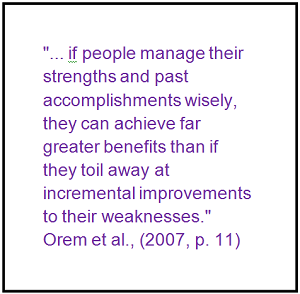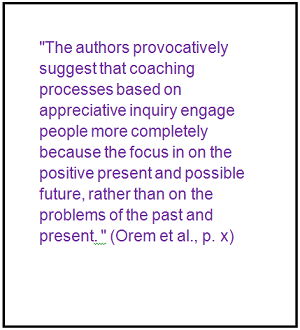Self Reflection
- Identify and assess your strengths.
- How do you use your strengths in your daily life?
- Identify how you have used your strengths to overcome challenges, and to contribute to your past and current accomplishments and successes.
- How could you use your strengths to an even greater degree to reach your ideal future?
- Select one of your top strengths and use it (in the next week) in a new way, either at home or at work.
- When were you at your best today?
- Observe your language – is it problem-focused or more appreciative? How can you use more appreciative language?
- Start a daily appreciative journal, noting 3 good things that occurred that day, and (most importantly) also note what you did to make each good thing happen.
- Orem et al., (2007, p. 18.) suggest that during the first session with a client, the discovery process begins by focusing on the strengths and accomplishments of the client, through asking the following four questions:
Answer these four questions for yourself.
Appreciative Coaching Perspective
 Even though coaching generally has a positive approach, the coaching session may focus on the client’s current problems, perhaps resulting from a client’s “weakness” and discussions may concentrate on what the client needs to do to overcome this weakness so the problem can be resolved.
Even though coaching generally has a positive approach, the coaching session may focus on the client’s current problems, perhaps resulting from a client’s “weakness” and discussions may concentrate on what the client needs to do to overcome this weakness so the problem can be resolved.
The appreciative coaching (AC) framework focuses on uncovering the individual’s innate strengths and abilities to help them move forward and realize their dreams (Orem et al., 2007).
Using a problem-solving approach, if a client was having a conflict with another person, the focus might be on when those kind of problems had occurred before, and how the client had handled them; on how/why the client has those types of problems with that kind of colleague; and if the client has these sorts of issues with other colleagues.
Using an AC approach, the focus would be on the client’s strengths and what he is already doing well, and how his strengths can be used to support him in dealing with this conflict. Now the coach might elicit from the client ways he could harness his strengths to accomplish his goals and handle the conflict. Perhaps the coach will have the client appreciate his colleague, valuing the strengths of the colleague so that he can maximize the contributions of both of them, creating a win-win situation to overcome the conflict and ensure successful completion of the project.
When using the AC approach, rather than paying attention to problems and obstacles and what causes problems, the coach focuses on what motivates and pulls the client forward. This results in a shift not only in how the coach assesses the client, but also in how the coach reframes, selects questions to ask, refocuses the client, chooses interventions, and which “homework” assignments to give (Kaufman, 2006).
Coaching Application
Kauffman (2007) recommends several steps to ensure that positive psychology is used in coaching. The first is that of helping clients to “reverse their focus” – so that instead of focusing on the negative, the coach supports the client in ensuring that attention is paid to the positive (Orem et al call this “pivoting”). Research studies demonstrate that this reversal results in enhanced well-being and more effective performance. An example of this is where a client has been given feedback that they are not an effective team-builder. Instead of focusing on what the client is doing wrong, the focus would be on what the client is currently doing right in terms of team building, and what other strategies the client could use to increase her team-building skills. The shift of perspective is small but very powerful – rather than “fixing” the “problem” the client will now be “accelerating” her team-building skills. The coach helps the client to identify and evaluate their strengths, which can then be applied in challenging situations and used to improve engagement, productivity and presence.
Kaufman (2006) also suggests that maximum performance can be achieved through “hope” psychology using two strategies. The first is when the coach supports the client’s ability to find alternative ways around obstacles (“pathways thinking”). The coach could ask powerful questions (e.g., “what would you do if you were your best self?”) and/or brainstorm with the client to generate ideas about ways of overcoming the obstacle. The second strategy is supporting the client in having a sense of “agency,” – a feeling that they are potent, capable of moving things forward, and can reach their goals. To assist the client in achieving a feeling of agency, the coach could have the client visualize success in a specific area, and ask the client to develop action steps which will move the client forward towards that success.
Coaching Reflections/Activities
- Have your clients answer the questions in the personal reflections section, above.
- How can you model an appreciative approach for your client?
- How can you help your client identify the best of what is right, at this very moment?
- With which of your clients, and in what instances, can you use the “reversal of focus” technique?
- Review your initial questionnaire and your session preparation form to ensure that they have an appreciative focus (i.e., you are not asking about obstacles or weaknesses).
- How can you take care of yourself, to ensure that you have a genuine belief in your client’s potential?
- Have your client identify their top strengths so you both know what inspires and motivates him/her.
- A variation on #8 in the self reflections exercises, which can be used in a work setting: ask the client what three things went right with the project today, and what did the client specifically do to make those good things happen? (Kaufman, 2006)
References
Gordon, S. (2008). Appreciative inquiry coaching. International Coaching Psychology Review, 3, special issue: Another look at executive and organisational coaching, March, pp. 19-31.
ICA (2009). Reframing Perspectives, p. 3.
Kaufman, C. (2006). Positive psychology: The science at the heart of coaching, in Stober, D. R. & Grant, A. M. (Eds), Evidence based coaching handbook: Putting best practices to work for your clients, 219-253. Hoboken, New Jersey: John Wiley & Sons,
Kauffman (2007, December). Four steps to putting positive psychology into your coaching psychology practice. Presentation at the 3rd national Coaching Psychology Conference. Unpublished manuscript. In Lavendt, E (20l1, April) Positive psychology coaching: An annotated bibliography from scholarly and practice-based literature. Center for Positive Psychology, Copenhagen, Denmark.
Orem, S. L, Binkert, J. & Clancy, A. L. (2007). Appreciative Coaching: A positive process for change. San Francisco: Jossey-Bass
